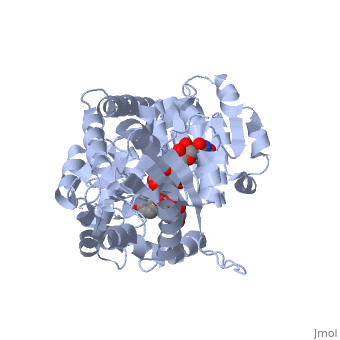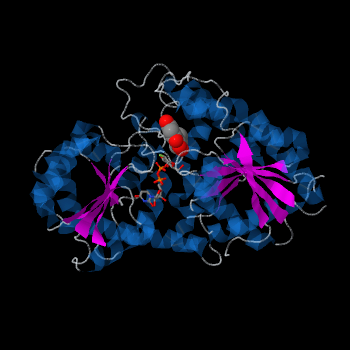Vitis vinifera Flavonoid 3-O-Glucosyltransferase (Vv3GT)
From Proteopedia
(Difference between revisions)
| Line 27: | Line 27: | ||
<scene name='69/692252/2c1z_pspg/1'>PSPG</scene> motif (Plant Secondary Product Glycosyltransferase motif). | <scene name='69/692252/2c1z_pspg/1'>PSPG</scene> motif (Plant Secondary Product Glycosyltransferase motif). | ||
| - | Three conserved motifs involved in sugar binding are present in Vv3GT. The first, a <scene name='60/607848/2c1z_loop_n5_label/1'>loopN5</scene> motif (Thr 141; Ala 142) involved in sugar binding. The second, a <scene name='69/692252/2c1z_wns_label/1'>WNS</scene> (Trp 354; Asn 355; Ser 356) motif residues are involved in binding UDP phosphates. The third, D/EQ motif residues also involved in sugar binding (Asp 374; Gln 375). The WNS and D/EQ motifs are part of the highly conserved PSPG region. | + | Three conserved motifs involved in sugar binding are present in Vv3GT. The first, a <scene name='60/607848/2c1z_loop_n5_label/1'>loopN5</scene> motif (Thr 141; Ala 142) involved in sugar binding. The second, a <scene name='69/692252/2c1z_wns_label/1'>WNS</scene> (Trp 354; Asn 355; Ser 356) motif residues are involved in binding UDP phosphates. The third, <scene name='69/692252/2c1z_d_eq_label/1'>D/EQ</scene> motif residues also involved in sugar binding (Asp 374; Gln 375). The WNS and D/EQ motifs are part of the highly conserved PSPG region. |
| + | |||
| - | This is a sample scene created with SAT to <scene name="/12/3456/Sample/1">color</scene> by Group, and another to make <scene name="/12/3456/Sample/2">a transparent representation</scene> of the protein. You can make your own scenes on SAT starting from scratch or loading and editing one of these sample scenes. | ||
</StructureSection> | </StructureSection> | ||
Revision as of 12:26, 24 January 2015
Your Heading Here (maybe something like 'Structure')
| |||||||||||
References
- ↑ Offen W, Martinez-Fleites C, Yang M, Kiat-Lim E, Davis BG, Tarling CA, Ford CM, Bowles DJ, Davies GJ. Structure of a flavonoid glucosyltransferase reveals the basis for plant natural product modification. EMBO J. 2006 Mar 22;25(6):1396-405. Epub 2006 Feb 16. PMID:16482224


